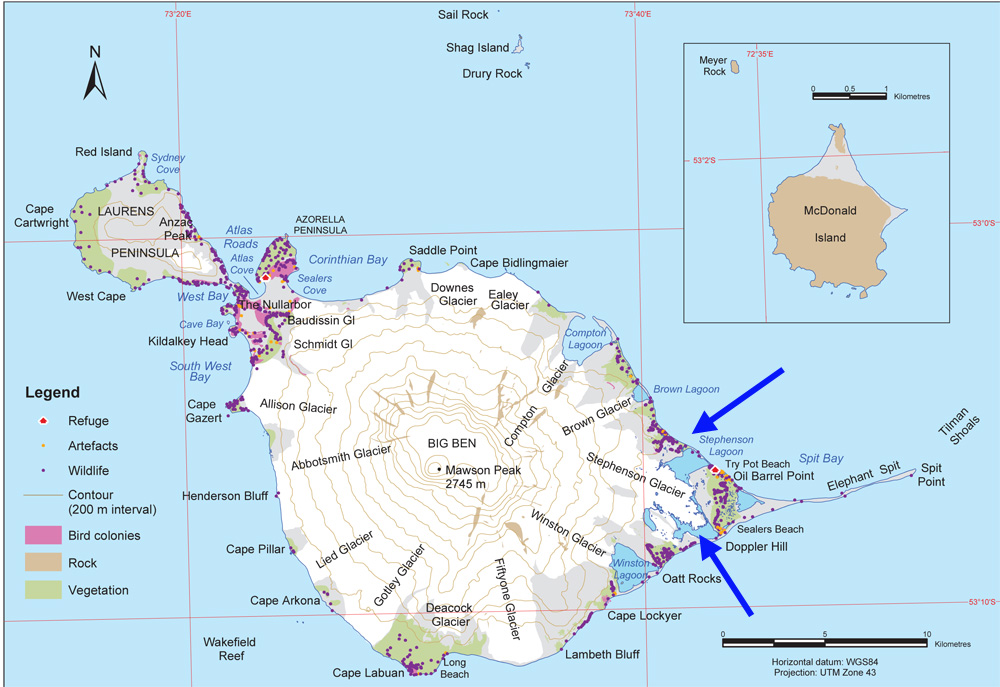February 4, 2019
Heard Island Retreat of Glaciers Enables Lagoon Development
Posted by Mauri Pelto
Stephenson Glacier (SG), Sephenson Lagoon (SL), Winston Glacier (WG) and Winston Lagoon (WL) in 2019 Sentinel Image.
The Australian Antarctic Division (AAD) manages Heard Island and has undertaken a project documenting changes in the environment on the island. One aspect noted has been the change in glaciers. The Winston, Brown and Stephenson Glacier have all retreated substantially since 1947 when the first good maps of their terminus are available. Fourteen Men by Arthur Scholes (1952) documents a year spent by 14 men of the Australian National Antarctic Research Expedition that documented the particularly stormy, inclement weather of the region. Their journey to the east end of the island noted that they could not skirt past the glaciers along the coast. After crossing Stephenson Glacier they visited an old seal camp and counted 16,000 seals in the area. It is a rich area for wildlife, that will benefit from the lagoon formation overall. Three species of seal commonly breed on Heard Island, southern elephant seals, Antarctic fur seal and sub-antarctic fur seals (AAD, 2019).
Here we examine the retreat of Stephenson Glacier and Winston Glacier from 2001-2019 and the consequent lagoon expansion. As Kiernan and McConnell observed retreat of Stephenson Glacier had begun by 1971 the glacier had retreated 1 km from the south coast and several hundred meters from the northern side of the spit. This retreat by 1980 caused the formation of Stephenson Lagoon.
Retreat of Stephenson Glacier and Winston Glacier from 2001 (red arrows) to 2018 (yellow arrows) in Landsat images.
In 2001 Stephenson Glacier has two separate termini, red arrows terminating in two separate lagoons, Doppler to the south and Stephenson to the east. There are numerous icebergs in Doppler lagoon but none in Stephenson Lagoon, indicating the retreat is underway. Winston Glacier terminates where the lagoon widens. In 2008 the two lagoons in front of Stephenson Glacier are joined with a narrow eastern channel, the lagoons are filled with icebergs as a terminus collapse is underway. Winston Glacier has retreated into a narrower inlet from the wider Winston Lagoon. By 2010 Stephenson Glacier had retreated from the main now singular Stephenson Lagoon, and like Winston Glacier in 2001 terminates at narrow point where the glacier enters the main lagoon. By 2018 Stephenson glacier has retreated from the main lagoon, the northern arm of the glacier experienced a 1.8 km retreat from 2001 to 2018 and the southern arm as 3.5 km retreat. The lagoon is free of ice for the first time in several centuries if not several millennia. The period of rapid retreat due to calving of icebergs into the lagoon is over and the retreat rate will now be slower. Winston Glacier has retreated 600 m from 2001-2018. The overall lagoon expansion has been limited as the glacier has retreated up an inlet that is 500 m wide.
The AAD has a number of images in their gallery of Heard Island glaciers including Stephenson Glacier. The climate station at Atlas Cove indicates a 1 C temperature rise in the last 60 years. The AAD will also certainly be looking at how this new lagoon impacts the local seal and penguin communities. The population of king penguins increased sharply from the 1940’s into the 21st century, while rockhopper, gentoo and macaroni penguins numbers declined over the same period (AAD, 2019).The map below indicates the importance of Stephenson Lagoon and Winston Lagoon for wildlife, king penguins and cormorants are noted by AAD. The retreat of this glacier follows the pattern of glacier retreat at other glaciers on islands in the circum-Antarctic region Cook Ice Cap, Kerguelen Island , Hindle Glacier and Neumayer Galcier, South Georgia.
Map of Heard Island from AAD.
Stephenson Glacier and Winston Glacier in Landsat images from 2008 and 2010. Terminus location of 2001 red arrows and terminus location in 2018 at yellow arrows.






 Dean of Academic Affairs at Nichols College and Professor of Environmental Science at Nichols College in Massachusetts since 1989. Glaciologist directing the North Cascade Glacier Climate Project since 1984. This project monitors the mass balance and behavior of more glaciers than any other in North America.
Dean of Academic Affairs at Nichols College and Professor of Environmental Science at Nichols College in Massachusetts since 1989. Glaciologist directing the North Cascade Glacier Climate Project since 1984. This project monitors the mass balance and behavior of more glaciers than any other in North America.
I was as Stephenson Lagoon in March 2016. We entered into the lagoon from the open sea in a RIB boat and passed through a wide, open channel into the lagoon. Took some depth measurements but don’t have them handy at the moment. Walked to the edge of the large tarn between Stephenson and Winston lagoon. Landed at several other locations on the shores of the lagoon. While exiting the lagoon were met by incoming breakers that made for a harrowing passage. Elephant Spit is now effectively an island. The north exit into the sea from Stephenson Lagoon looked navigable but we did not attempt it.